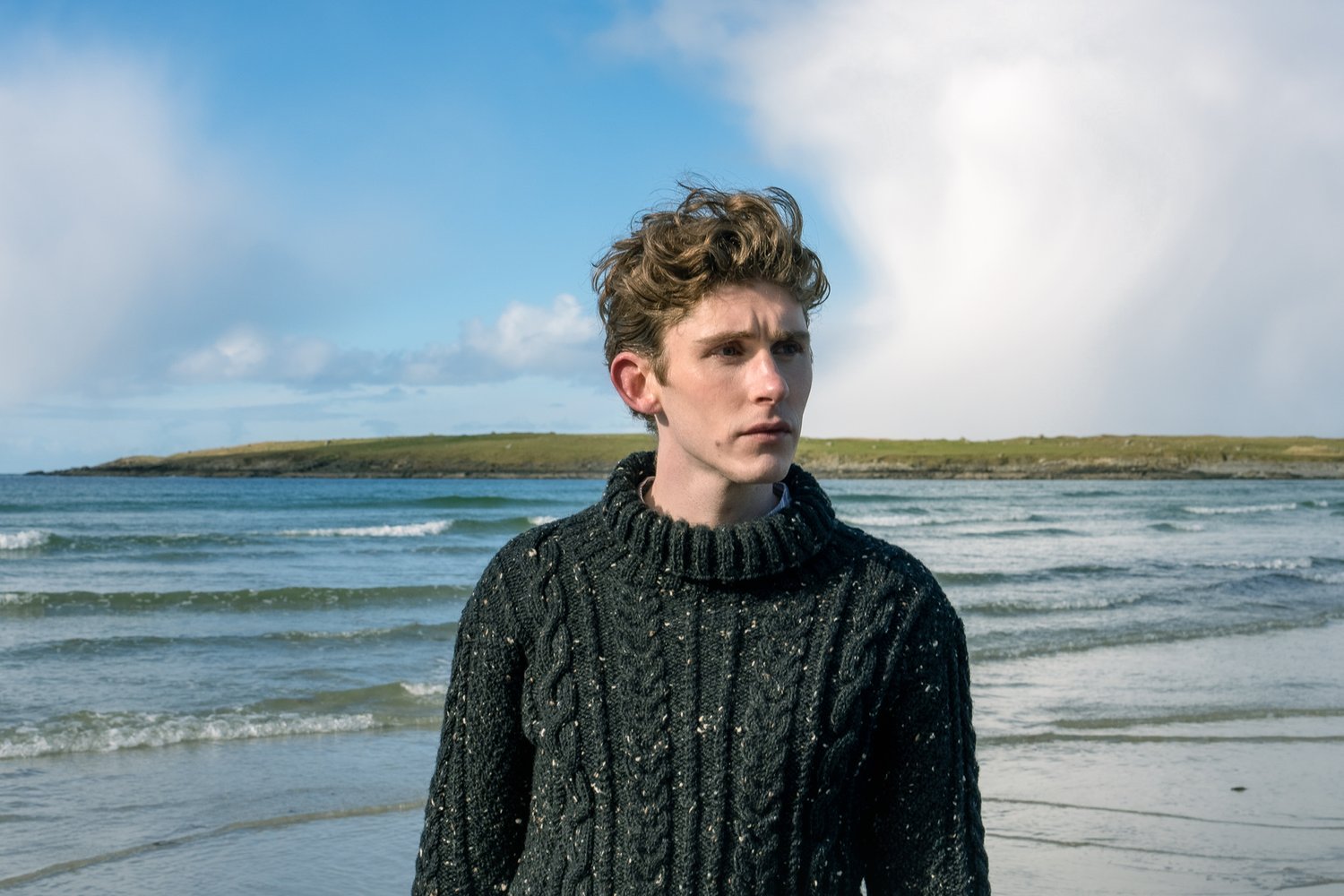Images courtesy of Quiver Distribution
FOUR LETTERS OF LOVE— 2 STARS
Throughout Four Letters of Love, two 1970s families in Ireland—one living on a remote western island and another from a more urban city home—experience difficult roads of distressing life events. Between them, there’s a drastic career change, the transition to a new school, future career uncertainty, parental abandonment, a few cases of writer’s block and artist’s block, relationship woes and competing affections before marriage, parental approval of their children’s paths, a handicapping injury, and two losses of parents and spouses. That’s a hell of a wringer coming from Niall Williams adapting his own 1997 bestseller for Let Me Go director Polly Steele. The question of whether or not it’s too much for a single movie depends greatly on how those events are handled by the characters.
Narrating the majority of Four Letters of Love is the young Nicholas Coughlan, played by the up-and-coming Irish actor Fionn O’Shea of Dating Amber and Cherry. He describes the catalyst of his family’s future state. One day, after many years of working at a desk job for the government, Nicholas’s father, William (the headlining Pierce Brosnan), claims God spoke to him and told him to stop everything and become a painter. Answer that heavenly call, he quits his work, abandons his wife (the beautiful and overqualified recording artist Imelda May), son, and earthly possessions to head to the western coast with a bag over his shoulder and a pair of canvases under his arm. The Survivalist cinematographer relishes this migration as a chance to show off the enriching grandeur of the Donegal and Atrium counties of the Emerald Isle that enraptures the film’s characters and gaze.
Meanwhile, the Gore family, living a ferry ride from shore on that western side of Ireland, is experiencing their own respective downturn. The patriarch, Muiris (a steady Gabriel Byrne), is a former poet who has lost his creative momentum and makes ends meet now as a schoolteacher. After a freak illness strikes, their son Sean (Dónal Finn of Fantastic Beasts: The Secrets of Dumbledore and Amazon’s The Wheel of Time) has become catatonic and wheelchair-bound, becoming a sad burden for his mother Margaret (the incomparable Helena Bonham-Carter and younger sister Isabel (Ann Skelly of HBO Max’s The Nevers). She is facing the prospect of leaving the family’s needs to head to the mainland for school, only to be amorously sidetracked by a whirlwind, troublemaking romance with Padraig (newcomer Conor Dan Ryan).
LESSON #1: CONFRONTING DIFFICULT LIFE EVENTS— Across these scattered lots in life in Four Letters of Love, personal responses are everything for addressing these many miniature sagas. In a different setting, culture, or historical period, lament would be verbalized in an exasperating way that overwhelms the bearer of stress. Therapy would be ordered to prevent hugely tragic and loud tailspins. That’s not the case in Steele’s film. The old Catholic guilt is too strong. Matching the pride and constitution often attributed to the Irish, resilience is the demanded trait. Tragedies and setbacks are simply additional opportunities to capitalize on spiritual beliefs or instinctual impulses.
Taking matters to a higher place of destiny, Nicholas’s introspective voicever in Four Letters of Love speaks of a painting that led him to his true love and meaning of life. That unseen painting comes from the father he has always felt emotionally distant from, now amplified further by William’s estrangement from his family. Coincidentally, Nicholas follows William west to find that his chosen and prophesied vista is the beach before the Gore family’s island. Bringing these two storylines within reach of happenstance’s grasp heavily suggests that the all-mighty yarns of fate will eventually tie Nicholas to a now-married Isabel.
LESSON #2: ARE FAITH AND DESTINY INDIVIDUAL OR LINKED?— In doing so, Four Letters of Love forces the ponderment of whether faith and destiny are individual or linked. For Isabel, she must find her own identity that is not defined by her brother’s tragedy or the diminishing luster of love happening with Padraig. For Nicholas, it is questioning how similar or dissimilar he is to his father’s sudden eccentricities while figuring out what kind of writer he is. Mixed in there are so-called miracles, a sliding scale of parental push that veers between embrace and meddlesomeness, and a measure of self-belief that must be settled before anyone joins with another in life, romantically or platonically.
LESSON #3: SOFTNESS AMID HARD MOMENTS— The tonal approach to frame all of this serendipity wrapped up in guilt circles back to the character choices referenced in Lesson #1. While resilience is still cardinal, there is a blanket of softness laid over Four Letters of Love that isn’t solely the signature sweaters everyone is constantly wearing. Pierce Brosnan’s William, at one point, describes his motivation for painting as “nothing less than supreme expressions of divine love.” Aiming that high, the novel and the film chose an unflappable loftiness.
By playing in those cinematic clouds to wipe away virtually all sources of pain with gestures of creative expression, Four Letters of Love is too slight. While Brosnan is granted a role with interesting motivational shifts, he is not the central focus of the film, even though he could surely carry it. Likewise, Byrne and Bonham-Carter, the other two actors on the ensemble with equally sterling resumes, are too often relegated to be wistful and worrisome parents. Their three presences of veteran talent should be stoking better fires of emotional passion.
Instead, any vital core is split between the two betrothed youngsters. Nicholas and Isabel comprise two solid stories here—a morose son learning to understand his father and find his creative niche, and a daughter becoming an independent spirit supported with the right love. Ann Skelly carries the vivacity and homespun radiance to cover her half, but Fionn O’Shea is staggeringly morose at all times in Four Letters of Love. Because the film keeps them apart so long (almost to the point where they shouldn’t have been combined in the first place), what transpires feels inconsequential for most of its running time, and the necessary romantic transformation never comes through for O’Shea’s half. If what is building and being portended is supposed to rattle with destiny and adoration as much as Nicholas narrates to be, then he has to come through with his part of the passion.
LOGO DESIGNED BY MEENTS ILLUSTRATED (#1325)



